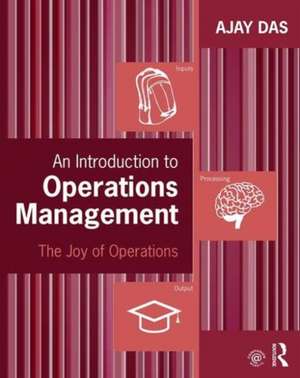An Introduction to Operations Management: The Joy of Operations
Autor Ajay Dasen Limba Engleză Paperback – 16 dec 2015
Students will benefit from the real-world scenarios that foster an understanding of operations management tasks. Without relying heavily on statistics and mathematical derivations, the book offers applied models and a simple, predictable chapter format to make it easy to navigate.
Students of introductory operations management courses will love this practical textbook. A companion website features an instructor’s manual with test questions, as well as additional exercises and examples for in-class use.
| Toate formatele și edițiile | Preț | Express |
|---|---|---|
| Paperback (1) | 500.05 lei 6-8 săpt. | |
| Taylor & Francis – 16 dec 2015 | 500.05 lei 6-8 săpt. | |
| Hardback (1) | 1200.50 lei 6-8 săpt. | |
| Taylor & Francis – 16 dec 2015 | 1200.50 lei 6-8 săpt. |
Preț: 500.05 lei
Preț vechi: 658.93 lei
-24% Nou
Puncte Express: 750
Preț estimativ în valută:
95.70€ • 103.91$ • 80.38£
95.70€ • 103.91$ • 80.38£
Carte tipărită la comandă
Livrare economică 23 aprilie-07 mai
Preluare comenzi: 021 569.72.76
Specificații
ISBN-13: 9780765645821
ISBN-10: 0765645823
Pagini: 670
Ilustrații: 434
Dimensiuni: 203 x 254 x 40 mm
Greutate: 1.25 kg
Ediția:1
Editura: Taylor & Francis
Colecția Routledge
Locul publicării:Oxford, United Kingdom
ISBN-10: 0765645823
Pagini: 670
Ilustrații: 434
Dimensiuni: 203 x 254 x 40 mm
Greutate: 1.25 kg
Ediția:1
Editura: Taylor & Francis
Colecția Routledge
Locul publicării:Oxford, United Kingdom
Public țintă
PostgraduateCuprins
Preface: How will this book help you? Introduction 1. Operations Management and You 1.1 What, exactly, is Operations? 1.2 Why is Operations management important? 1.3 How is it done? 1.4 Was it done right? 1.5 Current trends in operations management 1.6 How to read the book Part I: Designing Products and Processes 2. Product Design 2.1 What is product design? 2.2 Why is it important? 2.3 How is it done? 2.4 Have we done a good job? 2.5 Current trends in design 2.6 Conclusion 3. Process and Service Design 3.1 What is process design? 3.2 What is service design? 3.3 How is it done? 3.4 Trends in Process and Service Design 3.5 Conclusion Part II: Managing Processes 4. Managing Processes 4.1 What is process management? 4.2 Why is process management important? 4.3 How are processes managed? 4.4 Was it done right? 4.5 Current trends in managing processes 4.6 Conclusion Part III: Improving Process Performance 5. Forecasting 5.1 What is business forecasting? 5.2 Why is forecasting important? 5.3 How to make forecasting decisions? 5.4 Was it done right? 5.5 Current trends in forecasting 5.6 Conclusion 6. Capacity Planning 6.1 What is capacity planning? 6.2 Why is capacity planning important? 6.3 How is capacity planning done? 6.4 Was it done right? 6.5 Current trends in capacity planning 6.6 In Conclusion 7. Managing Capacity 7.1 What is capacity management? 7.2 Why is capacity management important? 7.3 How is capacity managed? 7.4 Was it done right? 7.5 Current trends in capacity planning 7.6 Conclusion 8. Managing Inventory 8.1 What is inventory management? 8.2 Why is managing inventory important? 8.3 How can we manage inventory? 8.4 Was it done right? 8.5 Current trends in managing inventory 8.6 In Conclusion Appendix: Managing Inventory 9. Managing Quality 9.1 What is quality? 9.2 Why is it important? 9.3 How is it done? 9.4 Was it done right? 9.5 Current trends in quality management 9.6 In Conclusion 10. Supply Chain Design 10.1 What is supply chain design? 10.2 Why is it important? 10.3 How is it designed? 10.4 Was it done right? 10.5 Current trends in supply chain design 10.6 Conclusion 11. Managing Supply Chains 11.1 What is supply chain management? 11.2 Why is it important? 11.3 How is it done? 11.4 Was it done right? 11.5 Current Trends in supply chain management 11.6 In Conclusion Part IV: Finding the Right Location 12. Managing Location Decisions 12.1 What is location? 12.2 Why is location important? 12.3 How to make location decisions? 12.4 Was it done right? 12.5 Current trends in location 12.6 Conclusion Part VI: Working with Projects 13. Managing Projects 13.1 What is project management? 13.2 Why is it important? 13.3 How is it done? 13.4 Was it done right? 13.5 Current trends in project management 13.6 In Conclusion
Notă biografică
Ajay Das is a Professor in the Operations Management group at the Zicklin School of Business, Baruch College, New York, USA. He has hands-on industry experience in operations and supply chain management and has published extensively in top-tier scholarly and professional journals including the Journal of Operations Management and the International Journal of Operations and Production Management.
Recenzii
'I am pleased to write an endorsement for An Introduction to Operations Management. Apart from the singularly interesting title, the book is unique in its approach to the presentation of operations management topics. It is written in conversational style, promoting easy understanding of the topic presented. The informal tone and logical structure of each chapter serve to pique students’ interest while the chapters contain numerous real-world examples and work-outs from contexts that students can immediately relate to, such as music and entertainment. The chapters contain ‘quick check’ boxes that can be used to check understanding.
The book is complete in content and eminently readable. The chapters focus on the what, why, and how of operations management, while delivering content in an engaging fashion. Student interest in learning the material is kept alive throughout the chapter by linking topics to their relevance and practical importance in actual applications. The topic coverage is salient to today’s operating environment in most firms. Das breaks new ground pedagogically, drawing on his vast experience in teaching operations management superbly to write a textbook that is not only different, but innovative in its approach to presenting the topics. Professor Das’ book is a welcome addition to textbooks on operations management.' - Ram Narasimhan, Michigan State University, USA
'Some of the words I have heard students use to describe operations are "not fun" or "boring." However, be ready to be surprised, Professor Das has brought "fun" and "joy" into operations.... sentences are short and crisp and there are lots of examples from the real world (e.g. see "OM in Practice" and various short cases shown in vignettes). Key points are repeated and reinforced in text, diagrams and vignettes. Chapters are written from the perspective of the millennials.
Professor Das begins with a chapter that has "you" in the title, referring to the student reader. He then builds the foundation by discussing product and process design and managing processes. He covers traditional topics such as forecasting, capacity planning, capacity management, inventory management, and quality management…skillfully weaves through these chapters covering technical issues as well as social and psychological issues. He adds supply chain design and supply chain management. He concludes the book by addressing location decisions and project management. The topics flow logically yet the chapters are written in such a way that an instructor can use different chapters separately. This book will be a joy to teach in an introductory operations management class.' - Thomas Y. Choi, Arizona State University, USA
‘Unlike many books that are seemingly written for instructors, this book is written with its readers in mind: 20-year-old marketing or finance majors who are only taking operations because it is required. Getting these students to see the value of operations has always been a challenge, but this book’s accessibility will make that a bit easier. Das manages to capture the attention of 20 year-olds without sacrificing academic rigor. Everything I would expect in an OM textbook is here. This book manages the difficult task of being both accessible and rigorous.’ -Mark Pagell, University College Dublin, Ireland
'The approach of Das's inventory chapter is refreshing and very different from the discussions in the traditional OM books. He has successfully merged OM and SCM concepts on inventory management for the undergraduate students by using great examples and a structure that flows easily through the chapter. The informal tone of the discussion brings down the concepts to a level of understanding for the undergraduate students that will, I feel, resonate with this population. Key aspects of business management practices related to the aspects of inventories are brought out well, including ideas on the traditional inventory models, safety stocks, service levels and retail inventory. The last one was particularly a good idea because students, as consumers, relate the aspects of inventory management at the retail stage more than any other stage in the supply chain. Concepts are covered in detail without making the quantitative portions too imposing to the student. I think this approach will make this book very suitable for the core OM course in undergraduate programs.' - Kaushik Sengupta, Hofstra University, USA
'This book has practical real world application for 21st century issues related to successfully launching and managing products and services for manufacturing and service industries. The comprehensive breadth and depth of the core concepts are easy to read and understand, and supported by examples, case studies, and test exercises. Personally, this book will be my "Go to" reference on my shelf. I am particularly keen on Capacity and Inventory Management applications for Business Advisory, Management Consulting and Technology Consulting domains that continues to be in my purview on a daily basis. Students will benefit from the contextual examples and relevance to career opportunities in this field, as well as alignment to related business functions in the manufacturing and service industries.' - Prakash Rao, Executive Director, Ernst & Young LLP, USA
The book is complete in content and eminently readable. The chapters focus on the what, why, and how of operations management, while delivering content in an engaging fashion. Student interest in learning the material is kept alive throughout the chapter by linking topics to their relevance and practical importance in actual applications. The topic coverage is salient to today’s operating environment in most firms. Das breaks new ground pedagogically, drawing on his vast experience in teaching operations management superbly to write a textbook that is not only different, but innovative in its approach to presenting the topics. Professor Das’ book is a welcome addition to textbooks on operations management.' - Ram Narasimhan, Michigan State University, USA
'Some of the words I have heard students use to describe operations are "not fun" or "boring." However, be ready to be surprised, Professor Das has brought "fun" and "joy" into operations.... sentences are short and crisp and there are lots of examples from the real world (e.g. see "OM in Practice" and various short cases shown in vignettes). Key points are repeated and reinforced in text, diagrams and vignettes. Chapters are written from the perspective of the millennials.
Professor Das begins with a chapter that has "you" in the title, referring to the student reader. He then builds the foundation by discussing product and process design and managing processes. He covers traditional topics such as forecasting, capacity planning, capacity management, inventory management, and quality management…skillfully weaves through these chapters covering technical issues as well as social and psychological issues. He adds supply chain design and supply chain management. He concludes the book by addressing location decisions and project management. The topics flow logically yet the chapters are written in such a way that an instructor can use different chapters separately. This book will be a joy to teach in an introductory operations management class.' - Thomas Y. Choi, Arizona State University, USA
‘Unlike many books that are seemingly written for instructors, this book is written with its readers in mind: 20-year-old marketing or finance majors who are only taking operations because it is required. Getting these students to see the value of operations has always been a challenge, but this book’s accessibility will make that a bit easier. Das manages to capture the attention of 20 year-olds without sacrificing academic rigor. Everything I would expect in an OM textbook is here. This book manages the difficult task of being both accessible and rigorous.’ -Mark Pagell, University College Dublin, Ireland
'The approach of Das's inventory chapter is refreshing and very different from the discussions in the traditional OM books. He has successfully merged OM and SCM concepts on inventory management for the undergraduate students by using great examples and a structure that flows easily through the chapter. The informal tone of the discussion brings down the concepts to a level of understanding for the undergraduate students that will, I feel, resonate with this population. Key aspects of business management practices related to the aspects of inventories are brought out well, including ideas on the traditional inventory models, safety stocks, service levels and retail inventory. The last one was particularly a good idea because students, as consumers, relate the aspects of inventory management at the retail stage more than any other stage in the supply chain. Concepts are covered in detail without making the quantitative portions too imposing to the student. I think this approach will make this book very suitable for the core OM course in undergraduate programs.' - Kaushik Sengupta, Hofstra University, USA
'This book has practical real world application for 21st century issues related to successfully launching and managing products and services for manufacturing and service industries. The comprehensive breadth and depth of the core concepts are easy to read and understand, and supported by examples, case studies, and test exercises. Personally, this book will be my "Go to" reference on my shelf. I am particularly keen on Capacity and Inventory Management applications for Business Advisory, Management Consulting and Technology Consulting domains that continues to be in my purview on a daily basis. Students will benefit from the contextual examples and relevance to career opportunities in this field, as well as alignment to related business functions in the manufacturing and service industries.' - Prakash Rao, Executive Director, Ernst & Young LLP, USA
Descriere
Students of introductory operations management courses will love this practical textbook. It features limited statistics and mathematics in favor of hands-on games, exercises, and plenty of real-world examples to help students gain a chronological view of operations management, and how it relates to the strategic goals of the firm.






















